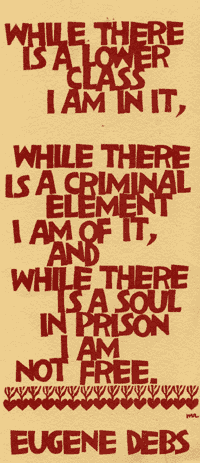
The Black Rage Defense and the Death Penalty:
What is the "black rage defense?" The simple answer is that it is a legal strategy which exposes environmental hardships to explain why a person commits a crime.
The law, through its rules of evidence, precedent and dogma, attempts to deny the effect of race and class. The concept of the colorblind courtroom is still the prevailing myth in the American Legal System. The black rage defense challenges that myth by thrusting social and economic reality into established legal doctrine.
It is important to understand that this defense is not an independent freestanding defense. Contrary to confused reports by the media, pundits, and some judges, no lawyer is arguing for a rule of law that says that because a person of color has suffered racial oppression it is a defense to his crime. The innovation of the black rage defense is that is takes standard legal categories such as insanity, diminished capacity, self-defense, duress and provocation, and uses social reality evidence -- discrimination, harassment, and poverty -- to bolster those defenses.
By expanding the traditional legal defenses people are educated to society's role in crime. Whether the black rage defense is used in plea bargaining, in trial, in mitigation proceedings or on appeal, it sheds light on the destruction of the human spirit caused by racial and economic injustice.
A highly publicized case was the New Jersey murder trial of Stephen Beverly. This trial shows how creative lawyers can fit the black rage defense into prevailing law and educate the public.
The night of July 29, 1997 was particularly tense at Bayside State Prison in New Jersey. A prison guard had threatened to separate convict Stephen Beverly from his cellmate and lover Favors Ali because their relationship was against the rules. A prison informant said Beverly had told him that if he and Ali were separated there would be a blood bath.
The next morning Corrections Officer Fred Baker entered Beverly and Ali's cell and told them to pack up their belongings as he was moving them to different units in the prison. A visibly shaken and angry Beverly asked this officer, who had made his life miserable for the past months, for boxes to pack his few possessions. Officer Baker responded: "No, I don't give boxes to niggers".
After the officer and Ali left the cell, Beverly went directly to the yard, dug up a shank, tightened the hood of his sweatshirt around his face, and returned to find Officer Baker on the phone. Rushing up to him, Beverly violently stabbed Baker in the back one time. The officer was mortally wounded. He staggered down the stairs and used his walkie-talkie to call for help. As another officer reached him he moaned, "Beverly stabbed me." Officer Baker then lost consciousness, dying soon afterward.
Meanwhile, Beverly had run over to his cellmate Ali, embracing him. He then went back to his
cell area where he quietly surrendered. As the officers took him into custody they heard him say: "I did it.
I killed the motherfucker. This didn't have to happen. I wrote the administration letters, they didn't do
anything. I contacted everyone about my problem and no one did anything. I didn't have to do it this way. I
didn't have to do it." Beverly was stripped naked, strapped into a "restraint chair" (which looks like an
electric chair) and had a helmet and face shield put over his face. he was kept in this condition for the entire
day, urinating on himself and being interrupted only by regular visits from a female nurse, as he yelled, in the
midst of panic attacks, "I can't breath."
Stephen Beverly was charged with first-degree murder and faced the death penalty. A few days later Beverly's lawyer, Jorge Godoy, sat in his Public Defender's office. There were only six other attorneys, a small support staff, and an already large caseload. He knew that there had to be hidden reasons behind Beverly's ferocious attack. If he was to save his client's life he would have to put together a team of lawyers, investigators, psychiatrists, and prison experts. They would have to discover the underlying causes of this homicide and fashion them into a legal defense. He was aware of a legal strategy called the "black rage defense," and began to research its applicability.
Beverly's state of mind when he stabbed Officer Baker did not satisfy the New Jersey legal test of insanity. However, Public Defender Jorge Godoy's understanding of prison life and racism motivated him to probe deeper into Beverly's life and to research the legal possibilities. The investigation led Godoy and private co-counsel Mark Catanzaro to conclude that a black rage defense fit within the state's passion/povocation rule which would reduce murder to manslaughter. The defense team was realistic, the chances of getting a manslaughter verdict was slim. But this strategy allowed Beverly's story to be told, provided a forum to expose the prison's racism and flowed seamlessly from the guilty phase to the penalty phase. As investigation unfolded, hopes rose that Beverly's life could be saved from the state-sanctioned murder he faced.
In any black rage defense, one must establish the particular, concrete interplay between the defendant and the oppression he/she faced. General evidence of racism, sexism and poverty which is not tied into the facts will not suffice and may even cause a backlash. Empathy grows out of the understanding of another's life. Rhetoric is an excuse for failing to do the hard work of investigation, and of spending time listening to one's client.
The legal team must merge the defendant's history with specific factors that led up to the crime. If racism and poverty work like "water torture," then the last drops of water on the defendant's forehead, driving him to the explosion, must be resurrected in detail.
Stephen Beverly was in prison for assault. His years in other prisons had been marked by problems. However, in his last year at Bayside Prison he had developed a reputation as a quiet inmate who kept to himself and did not cause problems. He was well liked by his fellow inmates and was "an excellent worker." His good behavior at Bayside was a result of his developing maturity and the stable, loving relationship he had with his cellmate Favors Ali. Ali was gay, and although Steven was not a homosexual, under confining conditions of prison life he began a loving relationship with Ali. They became emotionally bonded and in the prison vernacular were considered man and wife. They lived together in their cell for a year without any problems from the institution until Officer Baker arrived on the cell block.
A history of tension between defendant and victim is relevant to what constitutes adequate provocation. Officer Baker treated Beverly and his cellmate Ali with contempt calling them "homos" and "faggots." He humiliated and degraded them and created a poisonous atmosphere among some of the other guards resulting in cell-searches in which their few precious personal belongings were trashed.
Investigation uncovered corroboration of the prisoners' allegations that Bayside State Prison was a quagmire of racial prejudice dragging down guards and convicts alike. The Ku Klux Klan was reported to have recruited among the prison employees, and guards behaved as if in sympathy with the Klan. In a show of contempt for the Government some guard actually wore the American flag patch on their uniforms upside down.
The defense produced evidence of harassment during the six weeks leading up to the stabbing, describing specific instances of the dates of July 23, 26,27,28, and 29. Although Beverly and Ali filed formal grievances, by the morning of July 30 Stephen Beverly had lost all hope of the administration caring about the small amount of dignity he had been able to protect. His passions inflamed, he was now faced with the forced and spiteful separation from the one person in the world with whom he had a supportive relationship. An hour later the threat of administrative segregation and being called "nigger" caused those passions to burn Beverly up and consume Officer Baker in its awful fire.
The jury rejected the passion/provocation defense and convicted of first degree murder. But in the penalty segment of the trial Stephen's words echoed through the courtroom:"It didn't have to happen this way. I contacted everyone in the administration about my problem and no one did anything."
The jury spared his life. It was unanimous on two mitigation factors: "the Bayside administration permitted and fostered an environment in which racism flourished" and the administration did not properly respond to Beverly's complaints "so as to minimize or eliminate the anger and frustrations which caused Stephen Beverly to commit the offense."
An editorial in the Atlantic City mainstream newspaper, The Press, reflects how the black rage defense can have a positive effect on the public's consciousness of injustice.
"The jury heard a parade of inmates come to witness stand to tell of a prison system that tolerated racial slurs, beatings and threats. Correction officers enter a dangerous environment every day and deserve the respect of the community. The victim's family deserves better than to see Fred Baker and his colleagues put on trial for doing their job. Like the jury, we don't buy the defense argument that prison conditions drive Beverly to kill. In convicting Beverly of murder, the jury agreed that the act was calculated and premeditated. But in sparing Steven Beverly's life, the jury is sending a clear message that New Jersey's state prison system crosses the line. Despite the nature of the horrendous crime, the jury refused to issue the death penalty. The State Department of Corrections should take the verdict to heart. Jurors saw and heard about shocking conditions within the walls of Bayside State Prison. Let the Beverly verdict serve notice that those conditions are unacceptable to the citizens of New Jersey."
When Jorge Godoy first considered a black rage defense, people said "you've got to be crazy." Now he says the entire "culture" of his office has changed. Attorneys, legal workers, secretaries - all who participated in uncovering the reality of Stephen Beverly's life in prison and helping to communicate it in a public forum have experienced the expanding of legal horizons. They now understand the truth of Godoy's exhortation: "if we think it, we can do it."
The black rage defense is an anti-racist strategy. It assumes that people of different races, cultures and classes can understand and empathize with each other if given the chance to hear the evidence. It combines our political understanding of the real world with the legal knowledge gained in our sometimes dry and difficult years of law school. Its effective use required us to listen to our clients, see the strengths in them, and dignify their struggles as their advocates in a frightening legal system. Through our imagination, preparation and audacity we can save people's lives and help change the world.
For briefs and further info you may contact
Jorge Godoy, Public Defender
14 East Commerce St.
Bridgeton, N.J. 08302
(856) 453-1568
For a complete discussion of the black rage defense see the book by PAUL HARRIS, Black Rage Confronts The Law. Available from NYU Press (now in paperback) at 1-800-996-6987. Also available online.![]()